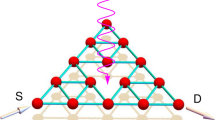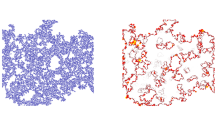Abstract
The dimensionality of an electronic quantum system is decisive for its properties. In one dimension, electrons form a Luttinger liquid, and in two dimensions, they exhibit the quantum Hall effect. However, very little is known about the behaviour of electrons in non-integer, or fractional dimensions1. Here, we show how arrays of artificial atoms can be defined by controlled positioning of CO molecules on a Cu (111) surface2,3,4, and how these sites couple to form electronic Sierpiński fractals. We characterize the electron wavefunctions at different energies with scanning tunnelling microscopy and spectroscopy, and show that they inherit the fractional dimension. Wavefunctions delocalized over the Sierpiński structure decompose into self-similar parts at higher energy, and this scale invariance can also be retrieved in reciprocal space. Our results show that electronic quantum fractals can be artificially created by atomic manipulation in a scanning tunnelling microscope. The same methodology will allow future studies to address fundamental questions about the effects of spin–orbit interactions and magnetic fields on electrons in non-integer dimensions. Moreover, the rational concept of artificial atoms can readily be transferred to planar semiconductor electronics, allowing for the exploration of electrons in a well-defined fractal geometry, including interactions and external fields.
This is a preview of subscription content, access via your institution
Access options
Access Nature and 54 other Nature Portfolio journals
Get Nature+, our best-value online-access subscription
$29.99 / 30 days
cancel any time
Subscribe to this journal
Receive 12 print issues and online access
$209.00 per year
only $17.42 per issue
Buy this article
- Purchase on Springer Link
- Instant access to full article PDF
Prices may be subject to local taxes which are calculated during checkout




Similar content being viewed by others
Data availability
All data is available from the corresponding authors upon reasonable request. The experimental data can be accessed using open-source tools.
Change history
09 July 2021
A Correction to this paper has been published: https://doi.org/10.1038/s41567-021-01265-5
References
Mandelbrot, B. B. The Fractal Geometry of Nature (W. H. Freeman, San Francisco, 1982).
Gomes, K. K., Mar, W., Ko, W., Guinea, F. & Manoharan, H. C. Designer Dirac fermions and topological phases in molecular graphene. Nature 483, 306–310 (2012).
Slot, M. R. et al. Experimental realization and characterization of an electronic Lieb lattice. Nat. Phys. 13, 672–676 (2017).
Collins, L. C., Witte, T. G., Silverman, R., Green, D. B. & Gomes, K. K. Imaging quasiperiodic electronic states in a synthetic Penrose tiling. Nat. Commun. 8, 15961 (2017).
Newkome, G. R. et al. Nanoassembly of a fractal polymer: A molecular ‘Sierpinski hexagonal gasket’. Science 312, 1782–1785 (2006).
Yu, B. Analysis of flow in fractal porous media. Appl. Mech. Rev. 61, 050801 (2008).
Dubal, D. P., Ayyad, O., Ruiz, V. & Gomez-Romero, P. Hybrid energy storage: the merging of battery and supercapacitor chemistries. Chem. Soc. Rev. 44, 1777–1790 (2015).
Fan, J. A. et al. Fractal design concepts for stretchable electronics. Nat. Commun. 5, 3266 (2014).
Rothemund, P. W., Papadakis, N. & Winfree, E. Algorithmic self-assembly of DNA Sierpinski triangles. PLoS Biol. 2, e424 (2004).
Shang, J. et al. Assembling molecular Sierpiński triangle fractals. Nat. Chem. 7, 389–393 (2015).
Li, C. et al. Construction of Sierpiński triangles up to the fifth order. J. Amer. Chem. Soc. 139, 13749–13753 (2017).
De Nicola, F. et al. Multiband plasmonic Sierpinski carpet fractal antennas. ACS Photon. 5, 2418–2425 (2018).
Hofstadter, D. R. Energy levels and wave functions of Bloch electrons in rational and irrational magnetic fields. Phys. Rev. B 14, 2239–2249 (1976).
Pan, W. et al. Fractional quantum Hall effect of composite fermions. Phys. Rev. Lett. 90, 016801 (2003).
Goerbig, M. O., Lederer, P. & Smith, C. M. On the self-similarity in quantum Hall systems. Europhys. Lett. 68, 72–78 (2004).
Morgenstern, M., Klijn, J., Meyer, C. & Wiesendanger, R. Real-space observation of drift states in a two-dimensional electron system at high magnetic fields. Phys. Rev. Lett. 90, 056804 (2003).
Richardella, A. et al. Visualizing critical correlations near the metal–insulator transition in Ga1−xMnxAs. Science 327, 665–669 (2010).
Evers, F. & Mirlin, A. D. Anderson transitions. Rev. Mod. Phys. 80, 1355–1417 (2008).
Domany, E., Alexander, S., Bensimon, D. & Kadanoff, L. P. Solutions to the Schrödinger equation on some fractal lattices. Phys. Rev. B 28, 3110–3123 (1983).
Ghez, J., Wang, Y. Y., Rammal, R., Pannetier, B. & Bellissard, J. Band spectrum for an electron on a Sierpinski gasket in a magnetic field. Solid State Commun. 64, 1291–1294 (1987).
Andrade, R. F. S. & Schellnhuber, H. J. Exact treatment of quantum states on a fractal. Europhys. Lett. 10, 73–78 (1989).
Wang, X. R. Localization in fractal spaces: Exact results on the Sierpinski gasket. Phys. Rev. B 51, 9310–9313 (1995).
van Veen, E., Yuan, S., Katsnelson, M. I., Polini, M. & Tomadin, A. Quantum transport in Sierpinski carpets. Phys. Rev. B 93, 115428 (2016).
Chakrabarti, A. & Bhattacharyya, B. Sierpinski gasket in a magnetic field: electron states and transmission characteristics. Phys. Rev. B 56, 13768–13773 (1997).
Liu, Y., Hou, Z., Hui, P. M. & Sritrakool, W. Electronic transport properties of Sierpinski lattices. Phys. Rev. B 60, 13444–13452 (1999).
Lin, Z., Cao, Y., Liu, Y. & Hui, P. M. Electronic transport properties of Sierpinski lattices in a magnetic field. Phys. Rev. B 66, 045311 (2002).
Crommie, M. F., Lutz, C. P. & Eigler, D. M. Confinement of electrons to quantum corrals on a metal. Surf. Sci. 262, 218–220 (1993).
Drost, R., Ojanen, T., Harju, A. & Liljeroth, P. Topological states in engineered atomic lattices. Nat. Phys. 13, 668–671 (2017).
Girovsky, J. et al. Emergence of quasiparticle Bloch states in artificial crystals crafted atom-by-atom. SciPost Phys. 2, 020 (2017).
Oftadeh, R., Haghpanah, B., Vella, D., Boudaoud, A. & Vaziri, A. Optimal fractal-like hierarchical honeycombs. Phys. Rev. Lett. 113, 104301 (2014).
Brzezińska, M., Cook, A. M. & Neupert, T. Topology in the Sierpiński–Hofstadter problem. Preprint at https://arXiv.org/abs/1807.00367 (2018).
Meyer, G. et al. Controlled manipulation of atoms and small molecules with a low temperature scanning tunneling microscope. Single Mol. 1, 79–86 (2000).
Celotta, R. J. et al. Invited Article: Autonomous assembly of atomically perfect nanostructures using a scanning tunneling microscope. Rev. Sci. Instrum. 85, 121301 (2014).
Sierpiński, W. Sur une courbe dont tout point est un point de ramification. Comptes Rendus Acad. Sci. 160, 302–315 (1915).
Bouligand, G. Sur la notion d’ordre de mesure d’un ensemble plan. Bull. Sci. Math 2, 185–192 (1929).
Foroutan-pour, K., Dutilleul, P. & Smith, D. Advances in the implementation of the box-counting method of fractal dimension estimation. Appl. Math. Comput. 105, 195–210 (1999).
Acknowledgements
We thank G.C.P. van Miert for the discussions. We acknowledge funding from NWO via grants 16PR3245 and DDC13, as well as an ERC Advanced Grant ‘FIRSTSTEP’ 692691.
Author information
Authors and Affiliations
Contributions
S.N.K. did the calculations under the supervision of C.M.S. The experiments were performed by M.R.S. with contributions from S.E.F. and S.J.M.Z. under the supervision of I.S. and D.V. All authors contributed to the interpretation of the data and to the manuscript.
Corresponding authors
Additional information
Publisher’s note: Springer Nature remains neutral with regard to jurisdictional claims in published maps and institutional affiliations.
Supplementary information
Supplementary Information
Supplementary Figures 1–18, mathematical derivations, and Supplementary References 1–29
Rights and permissions
About this article
Cite this article
Kempkes, S.N., Slot, M.R., Freeney, S.E. et al. Design and characterization of electrons in a fractal geometry. Nat. Phys. 15, 127–131 (2019). https://doi.org/10.1038/s41567-018-0328-0
Received:
Accepted:
Published:
Issue Date:
DOI: https://doi.org/10.1038/s41567-018-0328-0
This article is cited by
-
Emergence of fractal geometries in the evolution of a metabolic enzyme
Nature (2024)
-
Isolated flat band in artificially designed Lieb lattice based on macrocycle supramolecular crystal
Communications Materials (2024)
-
Atomically engineering metal vacancies in monolayer transition metal dichalcogenides
Nature Synthesis (2024)
-
Artificial kagome lattices of Shockley surface states patterned by halogen hydrogen-bonded organic frameworks
Nature Communications (2024)
-
Atomic-scale manipulation of buried graphene–silicon carbide interface by local electric field
Communications Physics (2024)



